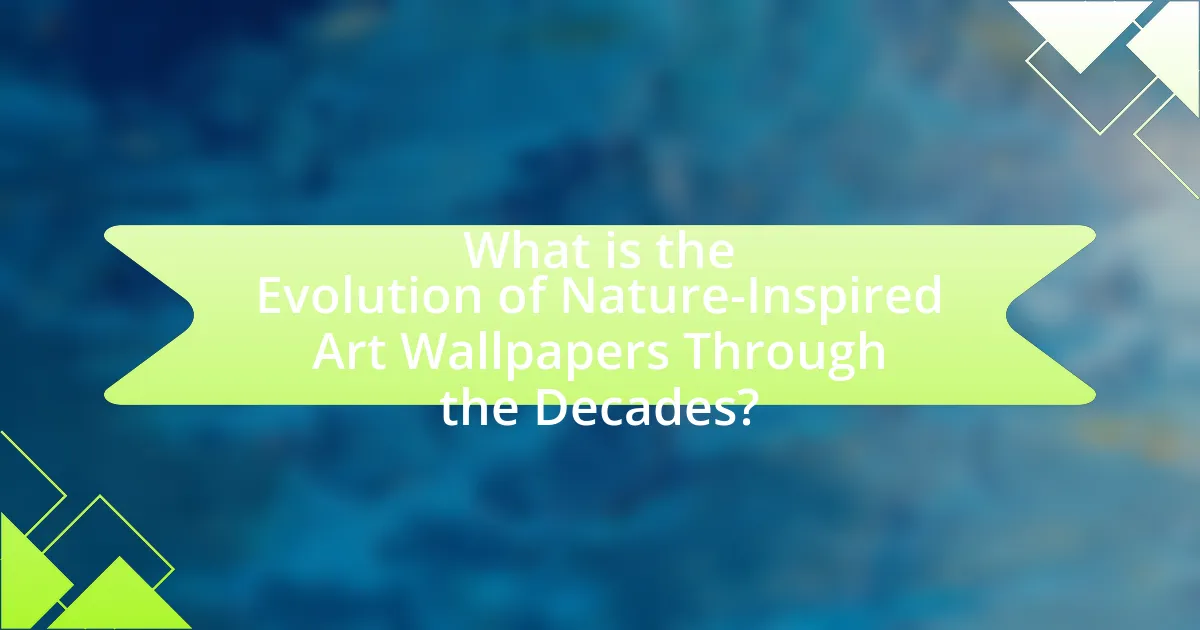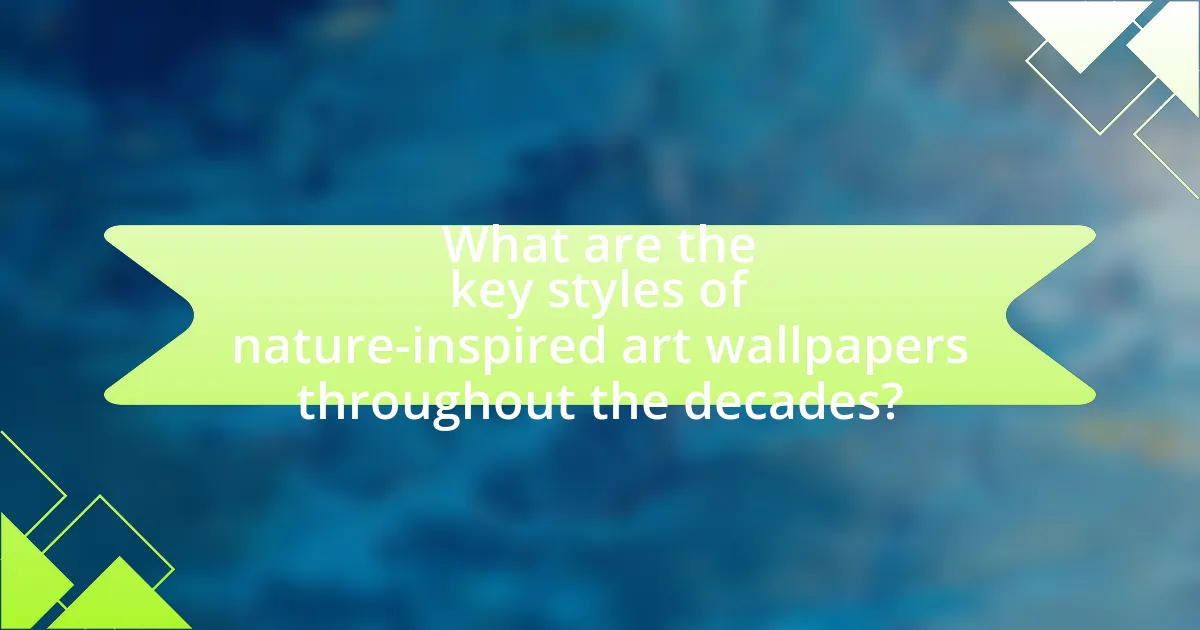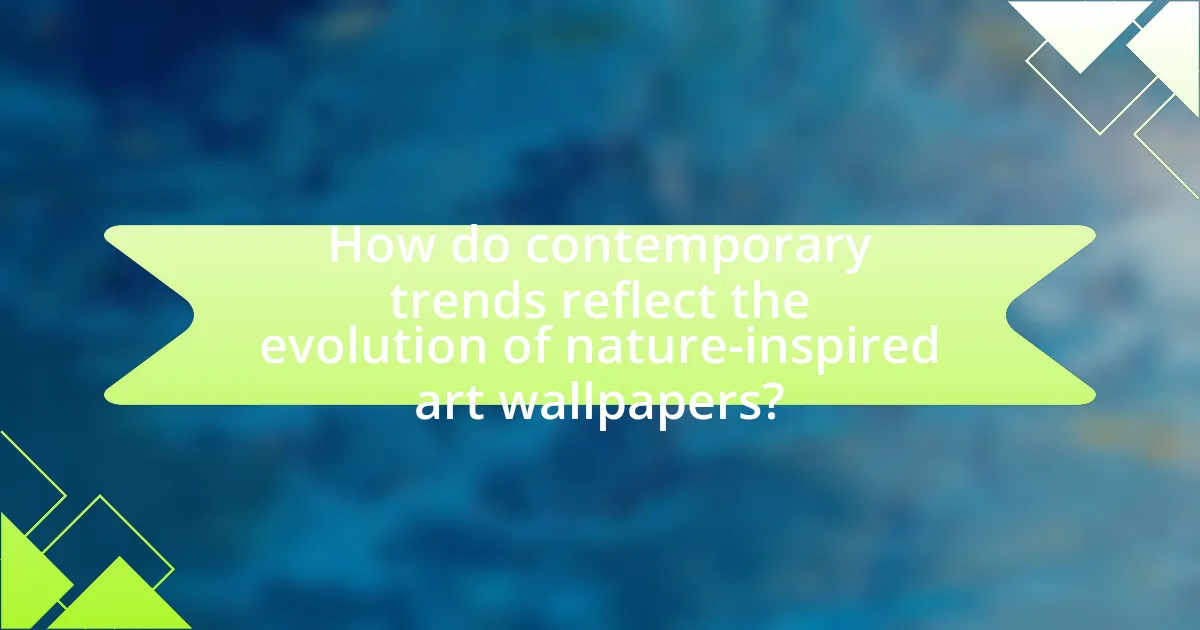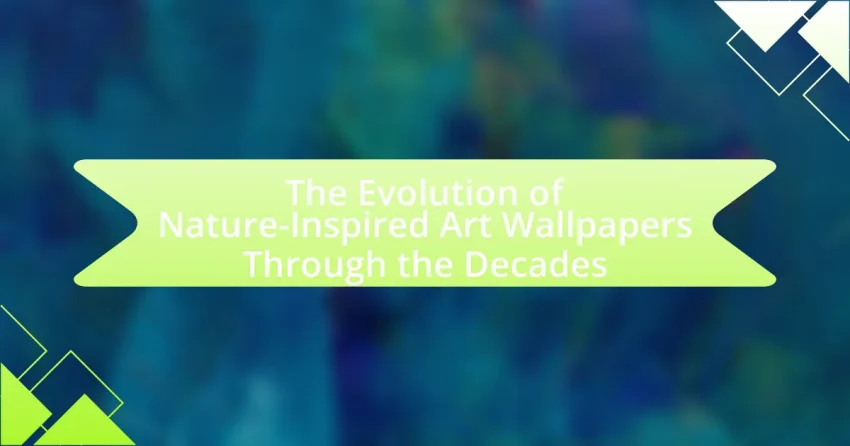The article examines the evolution of nature-inspired art wallpapers over the decades, highlighting the influence of artistic styles, technological advancements, and cultural shifts. It traces the transition from intricate, hand-painted designs in the 18th and 19th centuries to modern digital prints, showcasing key styles such as Art Nouveau, Mid-Century Modern, and contemporary eco-friendly designs. The discussion includes the impact of historical events, technological innovations, and consumer preferences on wallpaper trends, as well as the psychological effects of nature-inspired themes on well-being. Additionally, it addresses practical considerations for selecting and incorporating these wallpapers into home decor.

What is the Evolution of Nature-Inspired Art Wallpapers Through the Decades?
The evolution of nature-inspired art wallpapers through the decades reflects changing artistic styles, technological advancements, and cultural influences. In the 1960s, bold floral patterns emerged, influenced by the psychedelic movement, while the 1970s saw a shift towards more naturalistic designs, incorporating earthy tones and botanical illustrations. The 1980s introduced geometric patterns alongside nature themes, blending abstraction with realism. By the 1990s, digital printing technology allowed for more intricate and vibrant designs, leading to a resurgence of large-scale nature scenes. In the 2000s and beyond, eco-consciousness influenced wallpaper designs, emphasizing sustainability and organic motifs. This progression illustrates how nature-inspired art wallpapers have adapted to reflect societal trends and technological innovations over time.
How have nature-inspired art wallpapers changed over time?
Nature-inspired art wallpapers have evolved significantly over time, transitioning from intricate, hand-painted designs in the 18th and 19th centuries to modern digital prints. Initially, wallpapers featured detailed botanical illustrations and landscapes, reflecting the Romantic movement’s emphasis on nature. By the mid-20th century, the introduction of new printing technologies allowed for bolder colors and abstract interpretations of nature, such as stylized floral patterns. In recent years, advancements in digital printing have enabled the creation of high-resolution images that capture realistic details and textures, allowing for a diverse range of styles from photorealistic to minimalist designs. This evolution reflects broader artistic trends and technological advancements, showcasing a growing appreciation for nature in interior design.
What historical events influenced the design of nature-inspired wallpapers?
The design of nature-inspired wallpapers has been significantly influenced by historical events such as the Industrial Revolution, the Arts and Crafts Movement, and the rise of environmental awareness in the late 20th century. The Industrial Revolution, which began in the late 18th century, led to urbanization and a disconnection from nature, prompting a nostalgic longing for natural landscapes in home decor. This desire was further emphasized during the Arts and Crafts Movement in the late 19th century, where artists like William Morris advocated for handcrafted designs that celebrated nature. Additionally, the environmental movements of the 1960s and 1970s, spurred by events like the publication of Rachel Carson’s “Silent Spring,” heightened awareness of ecological issues, leading to a resurgence of nature-themed designs in wallpapers that reflect a commitment to sustainability and natural beauty.
How did technological advancements impact wallpaper production?
Technological advancements significantly transformed wallpaper production by introducing mechanized printing processes and improved materials. The advent of rotary printing in the 19th century allowed for faster and more intricate designs, enabling manufacturers to produce high-quality wallpapers at a lower cost. Additionally, the development of synthetic inks and durable substrates enhanced the longevity and vibrancy of wallpaper designs, making them more appealing to consumers. For instance, the introduction of vinyl wallpapers in the mid-20th century provided a washable and more resilient option compared to traditional paper, further expanding market possibilities.
Why are nature-inspired themes significant in art wallpapers?
Nature-inspired themes are significant in art wallpapers because they evoke a sense of tranquility and connection to the environment. These themes often reflect the beauty and diversity of nature, which can enhance the aesthetic appeal of interior spaces. Historical evidence shows that during the Arts and Crafts movement in the late 19th century, artists like William Morris emphasized natural motifs to promote craftsmanship and a return to nature, influencing wallpaper design significantly. Furthermore, studies indicate that incorporating natural elements in decor can improve mental well-being, making nature-inspired wallpapers not only visually appealing but also beneficial for psychological health.
What psychological effects do nature-inspired designs have on individuals?
Nature-inspired designs have a calming psychological effect on individuals, promoting relaxation and reducing stress. Research indicates that exposure to nature-themed environments can lower cortisol levels, which are associated with stress, and enhance overall well-being. A study published in the Journal of Environmental Psychology found that individuals exposed to nature-inspired designs reported higher levels of positive emotions and lower levels of anxiety. This effect is attributed to the innate human connection to nature, known as biophilia, which suggests that natural elements in design can evoke feelings of tranquility and happiness.
How do cultural perceptions of nature shape wallpaper trends?
Cultural perceptions of nature significantly influence wallpaper trends by dictating the themes, colors, and patterns that resonate with societal values and aesthetics. For instance, during the Romantic period, wallpapers featured lush landscapes and floral motifs, reflecting a deep appreciation for the natural world as a source of beauty and inspiration. In contrast, the rise of industrialization in the late 19th century led to a shift towards more abstract and geometric designs, mirroring the mechanization and urbanization of society. Additionally, contemporary trends often emphasize sustainability and eco-friendliness, with many designers opting for natural materials and motifs that evoke a sense of harmony with the environment. This evolution illustrates how wallpaper trends are not only a reflection of artistic styles but also a response to changing cultural attitudes towards nature.

What are the key styles of nature-inspired art wallpapers throughout the decades?
Key styles of nature-inspired art wallpapers throughout the decades include Art Nouveau in the late 19th to early 20th century, characterized by organic forms and floral motifs; Mid-Century Modern in the 1950s, which featured bold colors and abstract representations of nature; and Contemporary styles from the 2000s onward, emphasizing sustainability and realistic imagery. Art Nouveau, for instance, drew inspiration from natural forms, as seen in the works of artists like Alphonse Mucha, while Mid-Century Modern designs often incorporated stylized leaves and flowers, reflecting the era’s fascination with nature. Contemporary wallpapers frequently utilize eco-friendly materials and techniques, aligning with modern environmental values.
Which design movements have prominently featured nature-inspired wallpapers?
The design movements that have prominently featured nature-inspired wallpapers include Art Nouveau, Arts and Crafts, and Modernism. Art Nouveau, which flourished from the late 19th to early 20th century, emphasized organic forms and intricate floral patterns, as seen in the works of designers like Alphonse Mucha. The Arts and Crafts movement, emerging in the late 19th century, focused on handcrafted quality and natural motifs, with figures like William Morris creating wallpapers that celebrated botanical themes. Modernism, particularly in the mid-20th century, also embraced nature-inspired designs, integrating abstract representations of natural elements into wallpaper patterns, reflecting a shift towards minimalism and functionality.
What characteristics define Art Nouveau nature-inspired wallpapers?
Art Nouveau nature-inspired wallpapers are characterized by organic forms, flowing lines, and intricate patterns that mimic natural elements. These wallpapers often feature motifs such as flowers, leaves, and vines, reflecting the movement’s emphasis on harmony with nature. The use of soft, muted colors and a focus on craftsmanship further define this style, as seen in the works of artists like Alphonse Mucha, who popularized these designs in the late 19th and early 20th centuries. The combination of these elements creates a sense of fluidity and elegance, making Art Nouveau wallpapers distinct in their representation of the natural world.
How did the Mid-Century Modern era reinterpret nature in wallpaper design?
The Mid-Century Modern era reinterpreted nature in wallpaper design by emphasizing abstract forms, geometric patterns, and vibrant colors that reflected organic shapes and landscapes. Designers like Alexander Girard and Charles and Ray Eames utilized stylized representations of flora and fauna, moving away from realistic depictions to create a more playful and modern aesthetic. This shift was influenced by the post-World War II desire for innovation and a connection to nature, as seen in the use of motifs inspired by natural elements, such as leaves and flowers, rendered in simplified, bold designs. The incorporation of these elements into wallpaper design not only showcased the era’s artistic trends but also aligned with the broader cultural movement towards embracing nature in everyday life.
What are the most popular motifs in nature-inspired wallpapers?
The most popular motifs in nature-inspired wallpapers include floral patterns, botanical illustrations, landscapes, and animal imagery. Floral patterns often feature large, vibrant blooms and intricate leaf designs, reflecting the beauty of gardens and natural settings. Botanical illustrations emphasize detailed depictions of plants, showcasing their unique shapes and colors. Landscapes capture serene scenes such as mountains, forests, and rivers, creating a sense of tranquility and connection to the outdoors. Animal imagery often includes wildlife and birds, adding a dynamic element to the designs. These motifs have remained prevalent due to their ability to evoke feelings of calmness and a connection to nature, which is increasingly sought after in interior design.
How do floral patterns differ across various decades?
Floral patterns have evolved significantly across various decades, reflecting cultural, social, and artistic trends. In the 1920s, Art Deco introduced bold geometric shapes and stylized flowers, emphasizing luxury and modernity. The 1960s saw a shift towards psychedelic designs with vibrant colors and oversized floral motifs, influenced by counterculture movements. By the 1980s, floral patterns became more romantic and nostalgic, often featuring pastel colors and intricate details, aligning with the rise of cottagecore aesthetics. In the 2000s, minimalism gained popularity, leading to simplified floral designs with a focus on negative space and subtlety. Each decade’s floral patterns not only showcase artistic preferences but also mirror the societal values and technological advancements of the time.
What role do landscapes play in the evolution of wallpaper designs?
Landscapes significantly influence the evolution of wallpaper designs by providing thematic inspiration and aesthetic appeal. Historically, landscapes have been depicted in various styles, from realistic representations in the 18th century to abstract interpretations in modern designs, reflecting cultural and artistic movements. For instance, the introduction of pastoral scenes in wallpaper during the Rococo period showcased nature’s beauty, while the Arts and Crafts movement emphasized handcrafted designs inspired by natural forms. This evolution illustrates how landscapes not only serve as a source of inspiration but also adapt to societal changes, technological advancements, and artistic trends, thereby shaping the visual language of wallpaper throughout history.

How do contemporary trends reflect the evolution of nature-inspired art wallpapers?
Contemporary trends in nature-inspired art wallpapers reflect the evolution of design by emphasizing sustainability, digital technology, and biophilic design principles. These trends showcase a shift towards eco-friendly materials and production methods, aligning with a growing consumer demand for environmentally responsible products. For instance, the use of recycled materials and non-toxic inks has become prevalent, highlighting a commitment to sustainability in wallpaper production. Additionally, advancements in digital printing technology allow for intricate designs that capture the essence of nature with high precision, enabling artists to create more detailed and vibrant representations of natural landscapes. Furthermore, the integration of biophilic design principles, which focus on creating a connection between indoor spaces and the natural environment, is evident in contemporary wallpaper patterns that feature botanical motifs and organic textures. This evolution signifies a broader cultural movement towards valuing nature in interior design, reflecting both aesthetic preferences and environmental consciousness.
What modern techniques are used in creating nature-inspired wallpapers?
Modern techniques used in creating nature-inspired wallpapers include digital printing, 3D modeling, and eco-friendly materials. Digital printing allows for high-resolution images and intricate designs that capture the essence of nature, while 3D modeling enables the creation of textured surfaces that mimic natural elements. Additionally, the use of eco-friendly materials, such as recycled paper and non-toxic inks, reflects a growing trend towards sustainability in wallpaper production. These techniques enhance the visual appeal and environmental responsibility of nature-inspired wallpapers, aligning with contemporary design preferences.
How has digital printing transformed wallpaper design?
Digital printing has transformed wallpaper design by enabling high-resolution, customizable prints that allow for intricate patterns and vibrant colors. This technology eliminates the limitations of traditional printing methods, which often restricted designs to repetitive patterns and limited color palettes. With digital printing, designers can create unique, nature-inspired wallpapers that reflect personal styles and current trends, such as large-scale botanical prints or realistic landscapes. Additionally, digital printing facilitates shorter production runs, making it economically viable for designers to produce bespoke wallpapers without the need for large inventories. This shift has led to a significant increase in creativity and diversity in wallpaper design, allowing for more artistic expression and personalization in interior spaces.
What sustainable practices are being adopted in wallpaper production?
Sustainable practices in wallpaper production include the use of eco-friendly materials, water-based inks, and energy-efficient manufacturing processes. Manufacturers are increasingly opting for natural fibers such as organic cotton, hemp, and recycled paper, which reduce environmental impact. Additionally, water-based inks minimize harmful emissions compared to solvent-based alternatives. Energy-efficient production methods, such as utilizing renewable energy sources, further contribute to sustainability in the wallpaper industry. These practices are supported by industry standards and certifications, such as the Forest Stewardship Council (FSC) certification, which ensures responsible sourcing of materials.
How do current consumer preferences influence wallpaper design?
Current consumer preferences significantly influence wallpaper design by driving trends towards sustainability, personalization, and digital integration. As consumers increasingly prioritize eco-friendly materials, designers are responding by using sustainable resources and non-toxic inks, reflecting a broader shift towards environmental consciousness in home decor. Additionally, the demand for personalized aesthetics has led to a rise in customizable wallpaper options, allowing consumers to select patterns and colors that resonate with their individual tastes. Furthermore, the integration of technology, such as augmented reality features in wallpaper, caters to tech-savvy consumers seeking innovative and interactive home experiences. This alignment with consumer preferences not only shapes the aesthetic qualities of wallpaper but also its functional aspects, ensuring that designs remain relevant and appealing in a competitive market.
What are the emerging trends in nature-inspired wallpaper for interior design?
Emerging trends in nature-inspired wallpaper for interior design include the use of sustainable materials, bold botanical patterns, and immersive landscapes. Sustainable materials, such as recycled paper and eco-friendly inks, are increasingly favored due to growing environmental awareness among consumers. Bold botanical patterns, featuring oversized leaves and vibrant colors, are gaining popularity as they create a striking focal point in spaces. Additionally, immersive landscapes that depict serene natural scenes are being utilized to enhance tranquility and connection to nature within interiors. These trends reflect a broader movement towards biophilic design, which emphasizes the integration of natural elements into built environments to improve well-being and aesthetic appeal.
How do social media and online platforms shape wallpaper trends?
Social media and online platforms significantly shape wallpaper trends by facilitating rapid dissemination of design ideas and visual inspiration. Platforms like Instagram and Pinterest allow users to share and discover wallpaper designs, leading to viral trends that influence consumer preferences. For instance, the rise of nature-inspired wallpapers can be traced to popular posts showcasing botanical patterns, which gained traction through hashtags and user engagement. Additionally, online retailers often curate collections based on trending designs observed on these platforms, further reinforcing the popularity of specific styles. This interconnectedness between social media and wallpaper trends demonstrates how digital visibility directly impacts consumer choices and market dynamics.
What practical tips can be applied when choosing nature-inspired art wallpapers?
When choosing nature-inspired art wallpapers, prioritize selecting designs that resonate with your personal aesthetic and the overall theme of the space. Consider the color palette of the wallpaper; it should complement existing furnishings and decor to create a harmonious environment. Additionally, assess the scale of the patterns; larger designs can make a bold statement in spacious areas, while smaller patterns may work better in compact rooms.
Furthermore, evaluate the material of the wallpaper; vinyl options are durable and easy to clean, making them suitable for high-traffic areas, while fabric wallpapers can add texture and warmth. Lastly, ensure that the wallpaper is appropriate for the room’s lighting; natural light can enhance the vibrancy of colors, while dim lighting may require lighter shades to maintain brightness. These practical tips help ensure that the chosen wallpaper enhances the aesthetic appeal and functionality of the space.
How can one effectively incorporate nature-inspired wallpapers into home decor?
To effectively incorporate nature-inspired wallpapers into home decor, one should select designs that resonate with the overall aesthetic of the space. For instance, choosing botanical patterns can enhance a room’s freshness, while landscapes can create a sense of tranquility. Additionally, pairing these wallpapers with complementary furnishings, such as natural wood or earthy tones, can create a cohesive look. Research indicates that incorporating elements of nature in interior design can improve mood and well-being, as supported by studies from the University of Queensland, which found that natural elements in decor can reduce stress levels.
What considerations should be made regarding color and pattern selection?
Color and pattern selection should prioritize harmony, context, and emotional impact. Harmony ensures that colors complement each other, creating a cohesive look, while context involves considering the environment where the wallpaper will be applied, such as room size and lighting. Emotional impact relates to how colors and patterns evoke feelings; for instance, blue tones can create calmness, while vibrant patterns may energize a space. Research indicates that color psychology significantly influences mood and perception, supporting the need for thoughtful selection in design.
